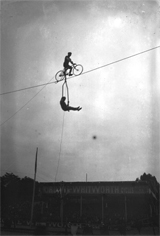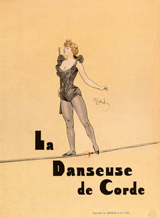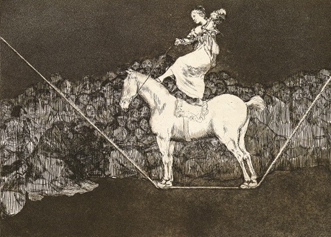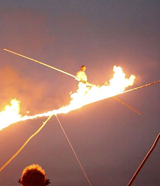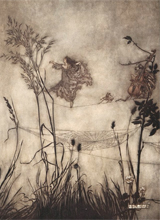by Pascal Jacob
In the middle of his novel Let the Great World Spin, the writer Colum McCann slipped in a photograph. The image is rectangular and in black and white. Therein, we see the towers of the World Trade Center linked together by a cable, with a man whose suspended silhouette takes the shape of a cross. Standing in the clouds, he dances over the void, opposite the 110th floor. The whole book revolves around this "tiny black figure in a stormy sky (encompassed by a) terrible, superb silence, in tune with himself."
The high wire inspires poets and philosophers because it is the metaphor of destiny and of its fragility, but it also symbolises the choice of an axis, a direction and the expression of a powerful desire to overcome the uncertainties of existence. For Nietzsche, "Man is a rope stretched between the animal and the superhuman – a rope above an abyss."
Desire of the void
"Tribute, prophet, or street artist,
Always fleeing with disdain
These cobbled streets which the passer-by tramples,
He walks on the proud summits
Or on the foul cord, but
Above the brows of the crowd."
Translated from Theodore de Banville, "The Stiff Rope " (La Corde roide), Odes funambulesques, 1856.
Taking on the high wire today means choosing to question the human being on his founding quest for the Other, on this impossibility of existing alone, without reflection or expression. The wire-walker is the incarnation of otherness: he draws unlimited courage from the depths of his being, dismisses fear and reason, sinking ever closer to the most acute terrors humanity has ever encountered, since it first contended with Good and Evil.
He suffers too, as Philippe Petit describes in his Traité du funambulisme: "Each second grates like a whetstone. A never-ending pain seizes your body, breaking it down muscle after muscle. If one resists and passes the threshold of the unbearable, then the torture will extend to the bones which will break one by one, penetrated by the wire. You will be a skeleton balancing on a blade.” But his self-sacrifice and love are stronger than the pain and anguish. Blinded by his desire for emptiness, he denies reality and rises to a level of unconsciousness that allows him to conquer it. He breaks through the mirror. In this image we find an elegant metaphor of the acrobat's stubbornness to push the limits, compressing reason into an ever-tightening leather belt, brushing off the slightest of obstacles that could contradict the success of this thing which, in the eyes of ordinary mortals, has no importance but which prevents him from living and sometimes from breathing until he has accomplished it. Maybe it is simply, as the wire-walker Jean-Thierry Baret nicely suggests, to "feel the air"... Composing with the void: on his wire, the acrobat is always at the centre of something. His body is an axis, his mobility a means of building a sequence. A simple taut wire, with no other trick, and it is a first step towards the mystery of balance or controlled imbalance; a living incarnation of the figure of the acrobat as a deliverer of progress.
Balance and asymmetry
According to Jean Clair in his illuminating introduction to La Grande Parade, "Man, the first primate to adopt the upright position, is also the first acrobat. Daring to stand on the ground, hesitating, moving forward and then, without stumbling, finding his way on two feet, he was among the mammals, the first wire-walker to traverse the invisible wire of his existence.”
Balancing on a wire creates a natural asymmetry, where the body constantly re-balances itself so it can move forward. It is this mixture of the wire’s tension and fragility, this permanently unresolved distance between balance and imbalance that seduces writers and poets. Within this image of the wire-walker or the rope dancer they find an infinity of pretexts to develop allegories and metaphors, playing with the idea of a link, of destiny and uncertainty.
When in 1820, Goya placed his horse and his Reina del Circo on a wire, which obviously rested on the ground, he entertained himself with an optical illusion, but he also created a powerful image where the planes are interwoven, kindling the doubts of those watching: is this balance, a complex and highly unlikely construction, ultimately (im)possible? Taking on the principle of fragility once again, other painters capture the figure of the wire-walker in safer and more logical compositions, but they still generate a poetry of emptiness and expectation. From the lightness of Jean-Louis Forain with his graceful and delicate Funambule in 1880, or from Toulouse Lautrec in 1899, and his Danseuse de corde who tip-toes, hesitating at the last moment, to test the suppleness of her apparatus before setting forth over the abyss; to the elegance of Everett Shinn with La Funambule in 1924 (oil on canvas), a ghostly, sparkling and slender silhouette, the counterpoint to a monumental, spectral chandelier that bathes the balcony of a theatre box in multicoloured light; to the fleeting visions in the extreme registers of Paul Klee, Max Beckmann or Marc Chagall whose mercurial creature haunts so many dark or transparent skies and who incarnates the sensation of the severity and intransigence of the wire.
Experiencing the Fall
Performing with a wire today is to dare to weave together the threads of man’s destiny differently. Dancing on the wire through the intermediary of unique bodies, who are themselves also accustomed to performing with doubt and limits, is to anchor another perception of love and failure in the flesh, blood and muscles. The acrobat denies the fall. He rejects it, with all his might, loathing and fleeing from it. Dancing, running, or jumping means repeatedly confronting the unspeakable, the unpredictable, the painful and nagging question of the fall. Being an acrobat is to force oneself to fall. To fall for no reason. Foiling one’s own power and accepting to fold, using one’s superhuman condition by agreeing to break it. Walking on a wire is to stroll along the edge of the abyss... Rope dancers and wire-walkers weave the story of a humanity that must die and be reborn without failing.
Walking on a wire is to forcefully give oneself over to the probability of a fall, which could be fatal. Death is a founding and draining issue. Definitive and decisive. Orpheus won the opportunity to replay his destiny. To untie and retie destiny’s threads. Dancing on the rope today, is to finally claim ownership of the destiny of Humanity, it is to give oneself, with or without a balancing pole, the chance to thwart despair and failure. To triumph.



